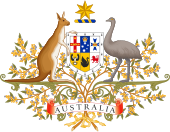Sex Discrimination Act 1984
| Sex Discrimination Act 1984 | |
|---|---|
 | |
| Parliament of Australia | |
|
The Sex Discrimination Act 1984 is an Act of the Parliament of Australia which prohibits discrimination on the basis of sex, marital or relationship status, actual or potential pregnancy, sexual orientation, gender identity, intersex status or breastfeeding in a range of areas of public life. These areas include work, accommodation, education, the provision of goods, facilities and services, the activities of clubs and the administration of Commonwealth laws and programs. The Australian Human Rights Commission investigates alleged breaches of the Act. The office of Sex Discrimination Commissioner, created in 1984 alongside the Act, is a specialist commissioner within the AHRC.
The Act implements Australia’s obligations under the Convention on the Elimination of All Forms of Discrimination Against Women which came into force in September 1981 and which Australia ratified in July 1983, subject to several reservations and declarations.[1] The Act also gives effect to parts of International Labour Organisation Convention 156 which concerns workers with family responsibilities.
Provisions
Among other things, the Act seeks to eliminate discrimination involving dismissal of employees with family responsibilities and to eliminate sexual harassment in areas of public activity.
The Act also seeks to create recognition and acceptance within the community of the principle of the equality of men and women.
Section 7AA of the Act prohibits discrimination against a woman on account of her breastfeeding.
As a result of the Act, the Women's Royal Australian Naval Service was integrated in 1985 into the Royal Australian Navy. Other restrictions on women in the WRANS had been eliminated previously: the restriction on married women serving was removed in 1969, and the automatic discharge of pregnant women had been dropped in 1974.[2] In 1991, the Sex Discrimination Amendment Act 1991 amended the Marriage Act 1961 to equalise the marriageable age of both males and females at 18 years, subject to "exceptional circumstances".[3] Previously the marriageable age was set at 16 for females and 18 for males. The rights and responsibilities of pregnant and potentially pregnant workers in the workplace were clarified by the Sex Discrimination Amendment (Pregnancy and Work) Act 2003. The foundational case on this issue is Hickie v Hunt & Hunt (1998)[4] in which the plaintiff complained of less favourable treatment in the workplace following her maternity leave.
See also
References
- ^ Declarations, Reservations and Objections to CEDAW
- ^ Christopherson, in Mitchell, Australian Maritime Issues 2010, p. 80-1
- ^ "ComLaw Acts - Attachment - Sex Discrimination Amendment Act 1991". Scaleplus.law.gov.au. Retrieved 2 August 2013.
- ^ Hickie v Hunt & Hunt [1998] HREOCA 8 (9 March 1998)
